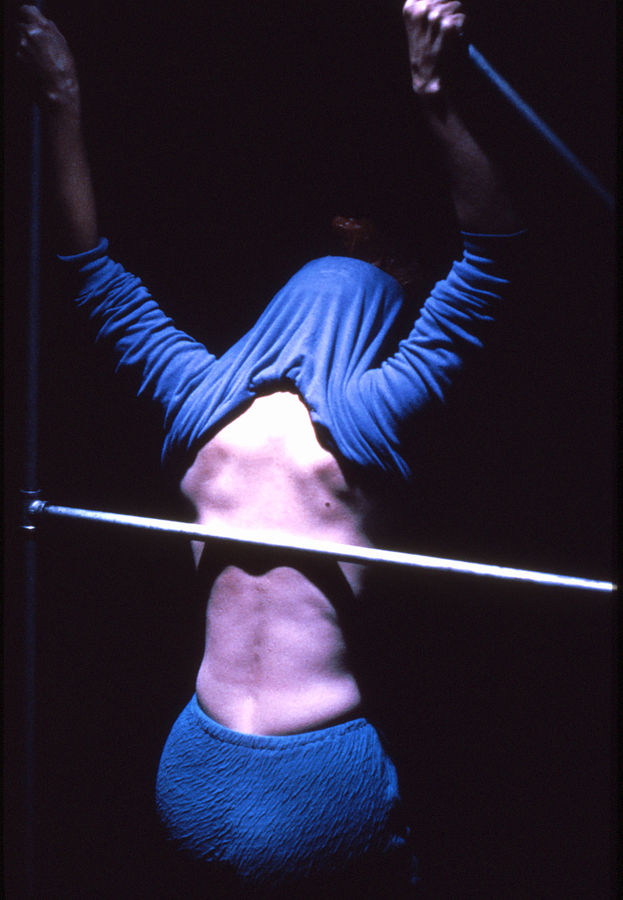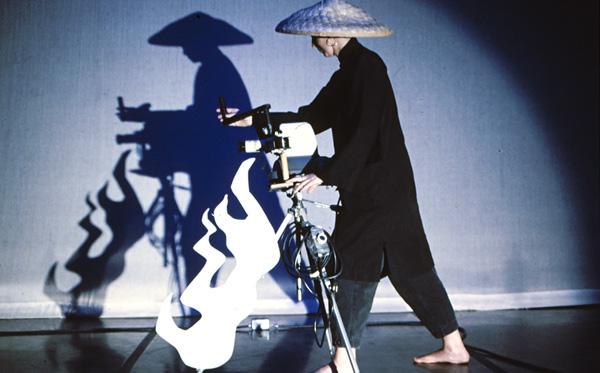Antebellum Bedlam

archival video
About the work
Antebellum Bedlam takes a tongue-in-cheek look at the General in the debriefing room during the conflict building up to the Korean War. He must cope with a possible world cataclysm while surrounded by the giddiness of the American-Japanese peace. At the center of activity is the hull of an American battleship off the coast of Japan. On the foredeck and bridge, a Multi-Image “Orchestra” of multiple projectors bombard the performance space with cartoon animations and irreverent goings-on to depict a Japan that prefers American prosperity to the return to war culture. Meanwhile, the debriefing of war prisoners in the War Room leads MacArthur toward a strategy to conquer Chinese troops in North Korea, and possibly China itself. Technical gizmos include a fleet of puppet ships sailing through air and a motorized rowboat taking a terrorist to the ship’s prow.Antebellum Bedlam was commissioned by Kala Institute for their Seeing Time Festival of Performance Art, and was staged in their atelier studios in Berkeley. This performance featured the first appearance of Doug Baird’s Multi-Image Orchestra--in the 1980s, slide projectors were the high tech solution for the projected image. MAFISHCO purchased all manner of antique projectors from the flea markets which the technical crew fitted out with rotation tables, rotating discs, cones, film strips and color wheels.
Antebellum Bedlam elicited the full spectrum of responses, and tried the patience of many, as is seen in the reviews below and the never-written review from a reviewer for High Performance who left at intermission.
Credits
- Choreography, Direction: Margaret Fisher
- Assistant Choreographer: Marla Carlson
- Music: Robert Hughes
- Lighting: Jim Quinn
- Set Design: Jerry Carniglia, Mara Lee Corter, Michael Bush
- Projection transport systems, low tech gizmos: Doug Baird, Dominica Kriz, Toyoji Tomita, Michael Bush
- Performers: Marla Carlson, Bob Hughes, Dominica Kriz, Toyoji Tomita
Reviews
- “Margaret Fisher in Three Pieces,” Wynne Delacoma, The Chicago Sun-Times, March 1, 1986. “It may be one of the stranger evenings you’ve spent in the theater. But anyone hungry for highly crafted art should head over to MoMing Dance & Arts Center tonight or tomorrow. Thanks to MoMing’s membership in the National Performance Network, California-based Ma Fish Co is in town. Thursday’s performance was a glimpse at a surreal universe too seldom glimpsed in Chicago’s mainstream theaters.
An interminable intermission preceded ‘Antebellum Bedlam,’ but the wait was worth it. With cartoon boats flying through the air, a sculpted battleship hiding projection equipment and cartoon animals flitting across various screens, the story of Korean War animosities and their aftermath felt like a grotesque cabaret show. Tomita was compelling as the smarmy sailor seducing the young woman who eventually murders him.” - “Limited Space cramps Fisher’s exhilarating style,” Janice Ross, The Tribune, August 10, 1985 “Fisher, the second artist in Kala’s summer performance series [Seeing Time Festival], creates mesmerizing theater works – dense layerings of stories, visions and subplots.... Over the last several years, as Fisher has grown as an artist, her theatrical images have increased in complexity and depth. Both ‘AG Nature’ and ‘Antebellum Bedlam’ entail rich mixtures of surrealist sets, props and symbolic costumes, Robert Hughes’ pulsating music and Fisher’s own witty and idiosyncratic choreography.”
- “Multicultural Mystifications,” Anthony Reveaux, Artweek, August 24, 1985. “Fish’s group of performances were a blend of Italian postfuturism and revisionist Japanese classicism, unified by Fisher’s choreographic sense of visual theater. Metaphorically speaking, it was a stimulating adventure in dining with unpredictable combinations of the sharp, the sweet and the pungent.”
“ Bedlam was the most theatrically and melodramatically accessible piece of the evening. ‘In postwar Japan, in anticipation of the Korean War,’ a captain plotted on a chartg table, both captain and table were tilted on their sides. A turret, armed only with the slide projectors of Doug Baird’s Multi-Image Orchestra, rotated on the prow of a large battleship. Images of racial discrimination, isolation and exoneration were projected on the walls while Carlson, Tomita and Fisher enacted various roles, such as a prisoner of war and a Japanese woman being hustled by a sailor. Antebellum Bedlam provided political specificity instead of abstracted illusionism and direct language instead of code, but it was strident and cluttered. It had strength and wit, however, and the production values were high.” - “Margaret Fisher’s Mind Games,” Allan Ulrich, San Francisco Chronicle, August 3, 1985. “Fisher has been at work for well over a decade, and it’s interesting to note how the times have passed her by. The sensory bombardment of ‘Antebellum Bedlam’ seems positively troglodytic in effect, especially when compared to the recent, all-enveloping pieces by the George Coates Performance Works (ironically, Fisher appeared in Coates’ latest, ‘Rare Area’).
“‘Antebellum Bedlam’ crowds together projections, live performers and both traditional and pop Japanese music for a mixed media assault on genocide as applied to the land of the rising sun. A noble idea and a striking design by Mara Lee Corter and Jerry Carniglia, but the piece is consistently sabotaged by the inertia of Fisher’s theatrical rhythm.”

Performance History
- Kala Institute, Seeing Time Festival, Berkeley, CA, July 31, August 1-3, 1985
- Video Screening of Antebellum Bedlam, Pro Arts Gallery, Oakland, CA, January 19, 1986
- MoMing Arts Center, Chicago, IL, February 27-28, March 1-2, 1986